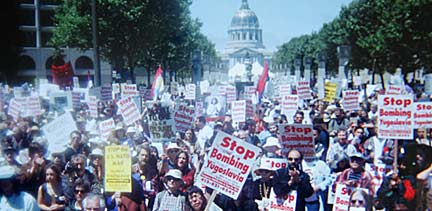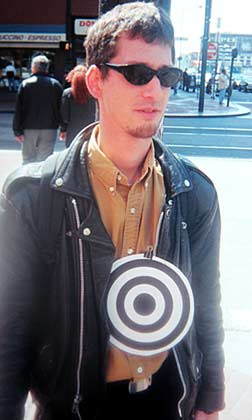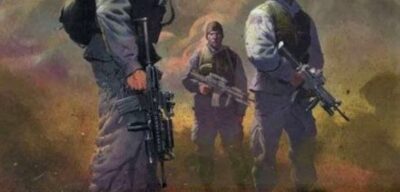Kosovo, Syria & WW3
I see things through the eyes of a socially engaged artist. Making art is intellectual work that entails conceptual thinking and problem solving, capabilities that must also be applied to the world of politics. As a painter I believe that art is the enemy of war, the converse is also true: war is the enemy of art.
In 1999 I created the pencil drawing that appears in this post as the U.S. and NATO were bombing Serbia and Kosovo. Titled We are all Targets, my drawing was inspired by those Serbian civilians who openly defied U.S. and NATO bombers by wearing target symbols while gathering on streets or bridges spanning the Danube river. The target symbol became an international antiwar icon that spread across the globe. Sadly, my drawing continues to be relevant, simply replace Serbians with Syrians. In truth, the drawing is a portrait of a protestor I spotted at an antiwar demonstration that took place in Los Angeles during that period. The artwork was made into a poster announcing the activities of the “Peace Center” of L.A., which at the time was coordinating anti-intervention marches and teach-ins against the war in Los Angeles.

I am alarmed to read that President Obama has been studying former President Clinton’s 1999 U.S. led NATO air war against the Serbs of the Federal Republic of Yugoslavia as a “blueprint” for military attacks against Syria. That U.S./NATO air war lasted 78 days and reaped enormous destruction. There are many parallels between that war and the conflagration looming in Syria – so many that I have an unnerving feeling of déjà vu.
As of this writing America has moved closer to war; on Sept. 4, 2013, the Senate Foreign Relations Committee voted 10 to 7 on a resolution to give President Obama authority to bomb Syria in response to the Syrian government’s alleged use of chemical weapons against civilians. The vote next goes to the full Senate, where the Democratic controlled chamber will most likely authorize Obama’s war. Whether or not the Republican controlled House rejects the war resolution remains to be seen. The steps towards war are being taken by the Democrats and Republicans despite the multiple polls that show Americans oppose the war in huge numbers.
All this while millions of Americans are out of work, deep in debt, or have lost their homes. Americans are looking at their communities literally falling apart. The U.S. economy has flat-lined and prospects for the near future are shaky at best. On Aug. 30, 2013 President Obama acknowledged that Americans are “war weary,” adding that “I assure you nobody ends up being more war-weary than me.” He went on to say that attacking Syria was vital “to our national security.” Yes, we are war weary alright, but we are also weary of clueless politicians sending us into unwinnable foreign wars.
Who knows what Obama’s strike against Syria will cost the U.S. taxpayer, likely hundreds of millions of dollars would be spent on weaponry and logistical operations. Each Tomahawk cruise missile Obama launches against Syria costs around $1.4 million each, and with the president saying his attack would “not put boots on the ground,” one can assume that a great number of cruise missiles will rain down upon Syria. The wars in Iraq, Afghanistan, and Pakistan, have so far cost upwards of $3.1 trillion. Mr. Obama’s war on Libya cost $1.1 billion (more on that later). A military strike against Syria will add untold millions – if not billions of dollars – to America’s war debt. War weary indeed.
Obama has said his strike against Syria will be a “limited, narrow act.” But there are no limited acts in warfare. The huge explosions from the hundreds of cruise missiles that Obama intends to send sailing into Syria will reverberate well into the future, and given the region, a wider full-scale war could result. The Sept. 4th Senate resolution included an amendment from Senator John “warmonger” McCain (R-Arizona) and Sen. Chris Coons (D-Delaware) that called for “democratic government in Syria,” in other words it’s regime change care of the Uniparty. The resolution also “limits” Obama’s strike to 60 days of military action, and a 30 day extension of the operation – that is 90 days of intense bombing – before having to come back to Congress for further authorization.
President Obama is on record saying that he does not need congressional authorization to strike Syria. Such an attack would violate Article I, Section 8, Clause 11 of the United States Constitution (“Congress shall have Power To declare War”) as well as the War Powers Resolution of 1973, which states that a President can only send U.S. armed forces into action abroad by a declaration of war by Congress or in “a national emergency created by attack upon the United States, its territories or possessions, or its armed forces.”
Obama is no doubt interested in how former president Clinton bypassed the U.S. Congress and the U.N. Security Council to wage the Kosovo war by executive order. It should be remembered that the U.S. House of Representatives refused to declare war against Yugoslavia in 1999, denying Clinton congressional authorization for the war. Despite not receiving approval from Congress, Clinton went ahead with the war. President Obama may well do the same.

A major difference between the Clinton led U.S./NATO assault on Kosovo/Serbia and Obama’s buildup to war with Syria is the total collapse of the so-called “antiwar movement” in the U.S., which for all intents and purposes folded itself into the Democratic Party and the 2008 presidential campaign of Sen. Obama. It has not regained its footing.
The American antiwar contingent against President Clinton’s war was small-scale at best, but nevertheless vocal and active. Opposition to President Obama’s militarism is almost non-existent.
One can only imagine how liberals and leftists who proclaim Obama to be an “antiwar president,” would be reacting if it was President Romney preparing to plunge the nation into war with Syria.
As the drums of war grow louder, there is only a deafening silence from liberals and leftists. It was not so during Clinton’s 1999 U.S./NATO bombing of Kosovo/Serbia, as the few artworks peppering this article illustrate.
Known as the “Kosovo War,” the 1999 conflict began as a secessionist movement, with ethnic Albanian Moslems striving to carve an independent state named Kosovo out of the Yugoslav province of the same name. By 1991 the “Kosovo Liberation Army” (KLA) launched a terror campaign against Serbian authorities, police, and villagers, precipitating a military response from the Serbian government of Slobodan Milošević. But the KLA also assassinated ethnic Albanians that opposed secession. The U.S. government had the KLA on its official list of terrorist groups, but inexplicably removed the organization from the list just before Clinton’s 1999 war. Robert Gelbard, the U.S. special envoy to the Balkans under the Clinton administration, said of the KLA in 1998, “I know a terrorist when I see one and these men are terrorists.”
The London Sunday Times ran an article on March 12, 2000 titled, CIA Aided Kosovo Guerilla Army All Along. The report disclosed that “American intelligence agents have admitted they helped to train the Kosovo Liberation Army before NATO’s bombing of Yugoslavia” in 1999. Furthermore, European diplomats said “this had undermined moves for a political solution to the conflict between Serbs and Albanians.”
Yugoslav army and Serbian militias within Kosovo carried out brutal reprisal attacks against the KLA, its supporters, and the general population of ethnic Albanians, killing an estimated 2,500 Kosovar Albanians in 1998.

President Clinton claimed the Serbs would commit genocide in Kosovo if the U.S. and NATO did not intervene. The U.S./NATO bombings started on March 24 and lasted until June 11, 1999—that’s 78 days of bombing by the greatest military power on earth.
First Lady Hillary Clinton said of President Clinton: “I urged him to bomb. You cannot let this go on at the end of a century that has seen the major holocaust of our time. What do we have NATO for if not to defend our way of life?”
Under the bombings, Serbian forces attempted to drive ethnic Albanians from Kosovo by force, which only increased the intensity of the U.S./NATO airstrikes. Suddenly the KLA were recast as “freedom fighters” by NATO and the two began to openly cooperate.
At the time small antiwar protests occurred across the U.S. in opposition to the Kosovo war, and demonstrations took place in New York, San Francisco, Los Angeles, and other big cities.
However, liberal and left circles were deeply divided, with many “progressives” siding with Clinton’s “humanitarian” bombing. “Laptop bombardiers” became a disparagement used by antiwar activists against supporters of Clinton’s war. Christopher Hitchens the author, left critic, and fallen socialist, became one of those bombardiers who cheered the bombing, calling Kosovo “Serbia’s Gaza.”
Numerous people, both left and right, mistakenly accused Clinton of launching the war in an attempt to deflect attention from “Monicagate,” the 1998 sex scandal that resulted from Clinton’s extramarital affair with the 22-year-old White House intern, Monica Lewinsky.
The 1997 film, Wag the Dog, caught the imagination of Clinton’s opponents, and the film’s title was commonly seen on placards at antiwar protests. The basic premise of the film was that of a U.S. president getting caught in a sex scandal with an underage girl. His staff hire a spin doctor and a Hollywood movie producer to concoct a distraction, which turned out to be a media-spectacle sham war with Albania. In a way the film turned out to be chillingly prescient. The scandal-plagued Clinton would two years later actually start a war, ostensibly to “protect” ethnic Albanians living in Kosovo.

However, the Wag the Dog movie is really about the relationship between government, the media, the “culture industry,” and manipulating the public into supporting the unsupportable.
Despite its flaws, it is a brilliant film whose narrative is as applicable to the present as it was to events occurring in the late 90s. But let us be clear, Clinton waged war, just as Obama does, for the interests of globalist empire. Wars are fought over resources, territory, and political interests – the “patriotic” and “humanitarian” concerns professed by leaders that instigate and conduct wars is often nothing more than propaganda.
As the American left intellectual Randolph Bourne wrote in the midst of World War I, “War is the health of the State.”
In the case of the Kosovo war the U.S. objective was controlling the strategic region and its oil flow. The region is expected to be the main route for a future central Asian pipeline that will carry oil and gas to the West. When the bombing stopped in 1999, the Pentagon constructed Camp Bondsteel in Kosovo; it is one of the largest U.S. military bases in the world.
Some 7,000 U.S. soldiers are based at Bondsteel, which also provides NATO’s KFOR with equipment and headquarters. This also falls in line with the U.S. military doctrine of “full-spectrum dominance,” which according to the U.S. Department of Defense, is “the cumulative effect of dominance in the air, land, maritime, and space domains and information environment that permits the conduct of joint operations without effective opposition or prohibitive interference.” In this case the “prohibitive interference” in the region is Russia.
In November 1998 the former United States Secretary of Energy, Bill Richardson, put it best when talking about U.S. policy regarding Caspian sea oil: “This is about America’s energy security. It’s also about preventing strategic inroads by those who don’t share our values. We’re trying to move these newly independent countries toward the west. We would like to see them reliant on western commercial and political interests rather than going another way. We’ve made a substantial political investment in the Caspian, and it’s very important to us that both the pipeline map and the politics come out right.”
As for Obama’s interest in Syria, that should be obvious. On Sept. 4, 2013 the New York based International Business Times (IBTimes) reported that Syria possesses “the largest conventional hydrocarbon resources in the eastern Mediterranean.” The IBTimes report quoted the Oil & Gas Journal’s estimate that Syria has around “2.5 billion barrels of crude oil,” putting it in second place behind Iraq. It also possesses some 50 billion tons of oil shale resources.
Russia and China play significant roles in Syria’s oil and natural gas production, and both countries are negotiating contracts with the Syrian government for offshore oil drilling rights. Removing Bashar al-Assad from power and replacing him with a puppet government, would not only give the West full access to Syria’s oil and gas, it would take Syrian oil and gas out of Russian and Chinese hands. Perhaps just as important in the West’s desire to destroy Assad is the strategy of isolating Syria’s ally, the Islamic Republic of Iran. With proven reserves of some 150 billion barrels of oil, nearly 10% of total global oil reserves, Iran is the ultimate goal.

In the Kosovo war U.S. and NATO bombers hit factories, oil refineries, government buildings, businesses, roads, bridges, airfields, and other civilian infrastructure targets in Yugoslavia.
On April 12, 1999, a U.S. F-15E Strike Eagle jet fired two missiles at the bridge spanning Grdelica gorge south of the Serbian capital of Belgrade. Instead of hitting the bridge, the missiles hit a passenger train, killing 14 civilians and wounding 16 others. The pilot said he did not see the train.
U.S./NATO bombers also managed to blow-up a good many ethnic Albanian civilian refugee columns attempting to flee the fighting. On April 14, a U.S. F-16 fired at a column at Đakovica, incinerating 73 non-combatants. There were many such attacks, more would come.
On April 19, 1999, the U.S. State Department claimed 500,000 Albanian Kosovars were “missing and feared dead.” Other statements from U.S. and NATO officials alluded to genocide and spoke of Serbian forces killing hundreds of thousands of Kosovars and burying them in mass graves.
On April 23, 1999, the U.S. fired four sea-launched cruise missiles at the private residence of President Milošević and his family in the Serbian capital in an obvious “decapitation” strike. The Washington Post reported that Clinton said the Serbian leader was not a target (!), and the U.S. Deputy Attorney General Eric Holder—yes, that Eric Holder, said the cruise missile barrage against Milošević was “consistent” with the U.S. prohibition on assassinating foreign leaders!

There were many egregious atrocities committed by both sides during the Kosovo war, but at the top of my list was the deliberate NATO bombing of the Belgrade headquarters of Radio Television of Serbia (RTS).
On the evening of April 23, 1999, NATO fired a cruise missile at the station while some 120 civilians were working in the building. Sixteen civilians were killed and another 16 were wounded. One young technician trapped beneath concrete slabs could only be pulled out of the rubble after rescuers amputated his legs. Hours after the bombing, Clare Short, the U.S. Secretary of State for International Development, announced that RTS was “a legitimate target” since it was “a propaganda machine.” Writing for The Independent on April 24, journalist Robert Fisk, who was stationed in Belgrade and witnessed the attack, wrote: “once you kill people because you don’t like what they say, you have changed the rules of war. And that’s what NATO did in Belgrade in the early hours of yesterday morning.”

On May 7, 1999, five U.S. “Joint Direct Attack Munition” (JDAM) smart bombs slammed into the Belgrade embassy of the People’s Republic of China, killing three Chinese citizens. The Chinese were outraged and condemned the bombing as a “barbarian act.” President Clinton said the bombing was a “mistake,” and the Pentagon attributed the error to an “outdated map.” A week later a NATO jet blasted a refugee column at Koriša, killing some 87 civilians and wounding 60. There would be dozens of such “mishaps” during the war.
Once the war was over and U.N. forensics teams of the International Criminal Tribunal for the former Yugoslavia (ICTY) entered Kosovo to search for and exhume mass graves containing the bodies of ethnic Albanian Kosovars – few could be found. The ICTY’s report of Nov. 1999 listed 2,108 victims found in graves, which led to articles like the Washington Post’s, Despite Tales, the War in Kosovo Was Savage, but Wasn’t Genocide.
The hunt for mass graves has continued, both in Serbia and in Kosovo. There is little doubt that more bodies will be found. The International Committee of the Red Cross, Kosovo’s Centre for Research, Documentation and Publication, and other organizations have reported that there are still 1,754 people missing from the war. Not to sound callous, but that is a far cry from 500,000 dead civilians. It is evident that U.S./NATO claims of genocide were totally fabricated.
It should be understood that when President Obama talks about “sending a message to Assad,” or “firing a shot across the bow,” with cruise missiles… the actual results will be incidents like those presented in the above.
In Syria, immediately after the chemical weapons attack allegedly carried out by the Assad regime, the medical organization Médecins Sans Frontières reported that 355 civilians had been killed. The Syrian Observatory for Human Rights, which is opposed to the Syrian government, claimed 502 people were killed – 46 of which were rebel fighters. The antigovernment Syrian Network for Human Rights said that 587 civilians were killed. The armed rebel group, Syrian Revolution General Commission put the civilian death toll at 635. Another opposition group, the Syrian National Coalition, reported that 650 civilians had died. U.S. Secretary of State John Kerry has said that the Obama administration “knows that at least 1,429 Syrians were killed in this attack, including at least 426 children.” Where did Kerry’s numbers come from?
On Aug. 25, 2013, upon hearing that UN weapons inspectors in Syria would be visiting the site of the chemical weapons attack to conduct an investigation and collect samples, a senior Obama administration official told the press that any findings made by the UN team would be “too late to be credible” because “the evidence available has been significantly corrupted” because of the passage of five days. On August 28, 2013, Scientific American ran an interview conducted with Charles Blair, the senior fellow on state and nonstate terrorist threats with the Federation of American Scientists. In that interview Mr. Blair discussed the scientific challenges of identifying chemical agents in the field, and said that traces of a nerve agent like sarin “should linger in the soil for up to 29 weeks.”
After ruminating over the reasons why the Assad regime might have launched the chemical weapons attack, Blair made the following point: “So then you look at the opposition – they had a lot more to gain through the use of chemical agents. From their perspective, [the opposition] likely understood that it would trigger a large-scale U.S. intervention. So you could have had a situation where they said yes, people are going to die, but more will die if we don’t do this [to] trigger U.S. intervention.”
On Aug. 28, 2013, Obama said the following about the chemical weapons attack: “We have concluded that the Syrian government in fact carried these out. And if that’s so, then there need to be international consequences. We do not believe that, given the delivery systems, using rockets, that the opposition could have carried out these attacks.” Mr. Obama did not offer any direct conclusive evidence to back up his assertion.
On Aug. 30, 2013, Obama said he had “high confidence” the Assad regime had gassed Syrian civilians; high confidence perhaps, but no confirmation. As a former professor and Senior Lecturer at the Law School of the University of Chicago, Obama knows that allegations, even ones that lawyers have “high confidence” in, do not win court battles – verifiable facts do. Obama also stated that the Syrian government has the types of munitions used in the chemical weapons attack, but UN weapons inspectors in Syria had not yet completed gathering evidence, let alone confirm what type of chemical agents were used in the attack when Obama made his statement. Moreover, on Sept. 4, 2013, regarding the U.N. inspection team’s findings, the Washington Post reported that “The Obama administration has asserted that the findings – expected in less than two weeks – no longer matter, citing its own evidence that the Syrian government was behind the chemical weapons attack last month.”
Carla Del Ponte served as the Chief Prosecutor for the ICTY from 1999 to 2007; the primary mission of the ICTY is to prosecute those responsible for war crimes. In Del Ponte’s case she prosecuted those who committed such crimes during the Kosovo war. She is currently a member of the U.N. Independent International Commission of Inquiry on the Syrian Arab Republic. Del Ponte stated in May of 2013 that U.N. human rights investigators suspect that Syria’s rebels have used sarin chemical weapons: “Our investigators have been in neighboring countries interviewing victims, doctors and field hospitals and, according to their report of last week which I have seen, there are strong, concrete suspicions but not yet incontrovertible proof of the use of sarin gas, from the way the victims were treated. This was use on the part of the opposition, the rebels, not by the government authorities.” Del Ponte’s statement casts reasonable doubt upon the Obama administration’s “high confidence” that the attacks were carried out by Assad.
Just who are the Syrian rebels?
Reuters reported that in August of 2012, President Obama signed a secret order that authorized $25 million in “non-lethal” covert aid to the Syrian rebels. Much of that aid went to the so-called Free Syrian Army (FSA), the main group of fighters backed by the U.S. and its allies; the Obama administration has also found other ways to support the FSA, like allowing U.S. based “support groups” to provide direct financial aid to the fighters. One of the major units of the FSA is the Farouq Brigades, which has some 20,000 men under arms. In May of 2013, Abu Sakkar, a commander of the Farouq Brigade, was video-taped cutting open the chest of a dead pro-government soldier and extracting the heart, Sakkar took a bite of the organ as he ranted, “I swear to God we will eat your hearts and your livers, you soldiers of Bashar the dog.” U.S. intelligence analysts view the Farouq Brigade as “moderately Islamist.”
In an Aug. 27, 2013 interview with The Hill, former Rep. Dennis Kucinich (D-Ohio) said “So what, we’re about to become Al Qaeda’s air force now? This is a very, very serious matter that has broad implications internationally. And to try to minimize it by saying we’re just going to have a ‘targeted strike’ – that’s an act of war. It’s not anything to be trifled with.”
On Sept. 2, 2013, President Obama touted that he had won support for bombing Syria from Republican Senators John McCain (R-Arizona) and Lindsey Graham (R-South Carolina). The two were among the first U.S. Senators to express open support for Obama’s war plans against Syria. One should recall that Sen. McCain traveled to Syria in May of 2013 to meet with the anti-government “Free Syrian Army.” After promising more support for their cause, McCain was photographed with FSA soldiers. Not long after it was noticed that two of the gunman posing with the Senator had been part of a kidnapping ring that seized and held Shia religious pilgrims for ransom in order to finance the war against the Assad regime. McCain’s office responded that the Senator had no idea the FSA men were hostage takers, but this only reveals the fatal flaw in U.S. government support for the Syrian rebels… which ones are “moderates” and which ones are religious fanatics, and how exactly does one tell them apart?
At congressional hearings during the week of Sept. 2013, Secretary of State John Kerry made a remarkable statement in response to a question from Representative Michael McCaul, a Texas Republican. McCaul asked, “Who are the rebel forces? Who are they? I ask that in my briefings all the time. And every time I get briefed on this it gets worse and worse, because the majority now of these rebel forces – and I say majority now – are radical Islamists pouring in from all over the world.” Mr. Kerry replied:
“I just don’t agree that a majority are al Qaeda and the bad guys. That’s not true. There are about 70,000 to 100,000 oppositionists … Maybe 15 percent to 25 percent might be in one group or another who are what we would deem to be bad guys.”
The U.S. government has made it its business to hunt down al Qaeda terrorists and kill them wherever they are found – or so we have been told. Is that not what the “war on terror” has supposedly been all about? The Bush and Obama administrations have spent trillions of dollars mobilizing the military to destroy al Qaeda in Iraq and Afghanistan – occupying those countries for years in the process. The two administrations have pursued individuals and small groups of what were said to be al Qaeda operatives, in remote areas of Yemen, Pakistan, Sudan, and Afghanistan and killed them with Hellfire missiles fired from Predator drones. Even an American citizen, Anwar Al-Awlaki, was killed in a drone strike carried out in Southern Yemen, though charges were never made against him. But now the U.S. government is pushing to support and arm an insurgency that al Qaeda is fighting in?
Kerry made his remark only a few days before the 12th anniversary of Sept. 11, 2001. Remember the sentiment, “Never Forget 9/11.” Now the U.S. government says that only 25 percent of an insurgent movement it supports in Syria is composed of al Qaeda fanatics! At the congressional hearings Kerry went on to say that “moderate” opposition groups in Syria are gaining in strength and influence, but U.S. intelligence sources are saying that the al Qaeda affiliate, the Nusra Front, is the strongest and most effective fighting force. What happens if the Assad regime is toppled and the al Qaeda affiliated armies take control? What then Mr. President? Perhaps we can see Syria’s future in Libya.
In his build-up to war against Libya, President Obama told members of the U.S. Congress that military action would last for “days, not weeks.” The president refused to call it a war, instead dubbing it a “kinetic military action.” Obama conducted his war on Libya without authorization from Congress. He ignored the War Powers Resolution, arguing that it did not apply since military operations were “limited in their nature, duration, and scope” and did not involve U.S. combat troops on the ground. The U.S./NATO attack began on March 19, 2011 and continued until October 20, 2011, when NATO bombers attacked Maummar Gaddafi’s convoy as it fled the city of Sirte. The wounded Gaddafi was seized by Libya’s “rebels,” who ran a knife up his anus before killing him.
And what are the fruits of Obama’s “liberation” of Libya? It is a nation now overrun by Islamic militias; the militants that Obama and NATO armed in their war against Gaddafi attacked the U.S. diplomatic mission at Benghazi on Sept. 11, 2012, killing the U.S. Ambassador and three other Americans; Libya’s dysfunctional U.S. backed government is controlled by the ruling “Justice and Construction party” – formed by the Muslim Brotherhood in March of 2012, and the country has become al Qaeda’s headquarters in the region. A war that topples Syria’s President Assad will likely end with the same results.


